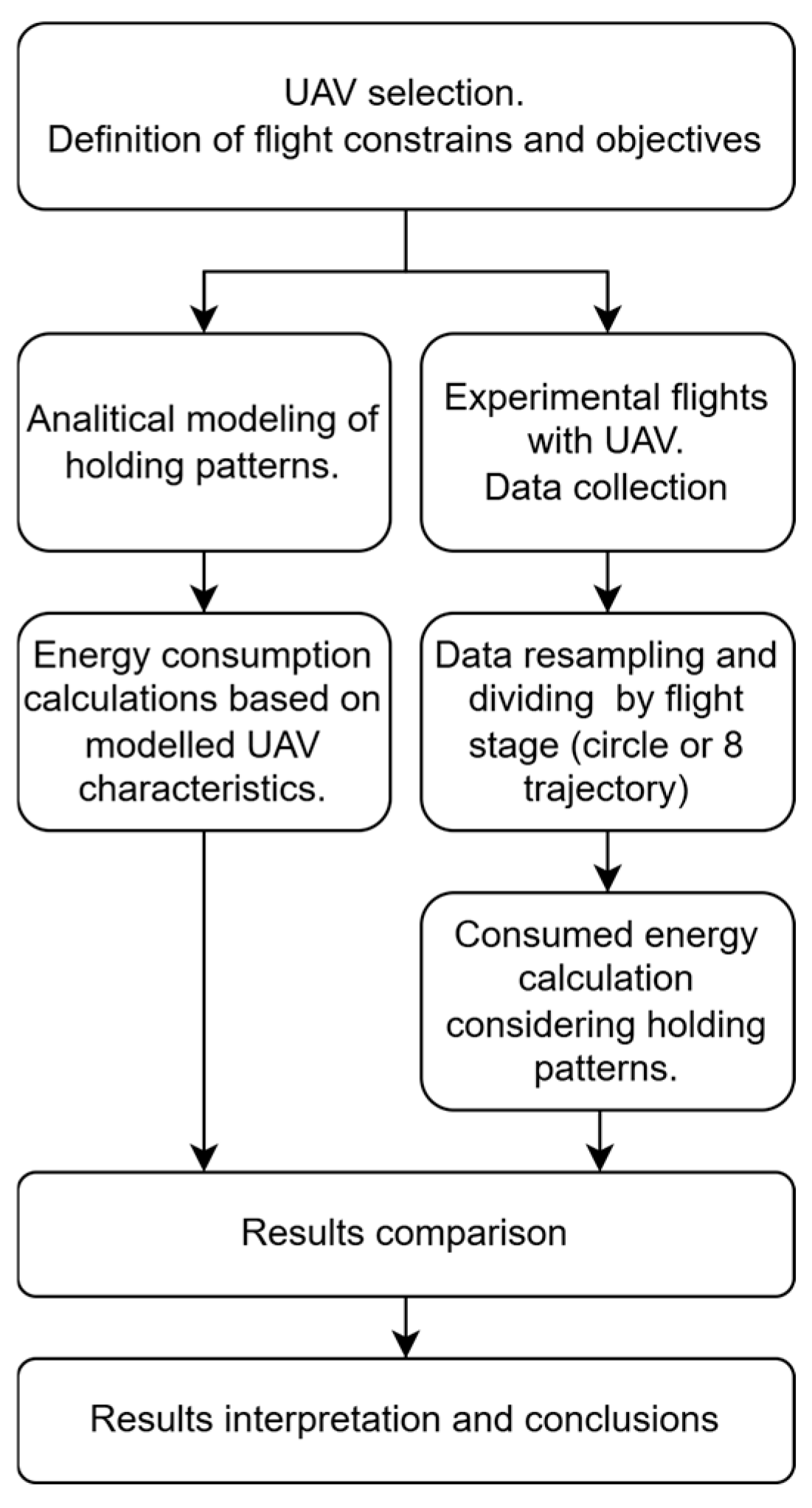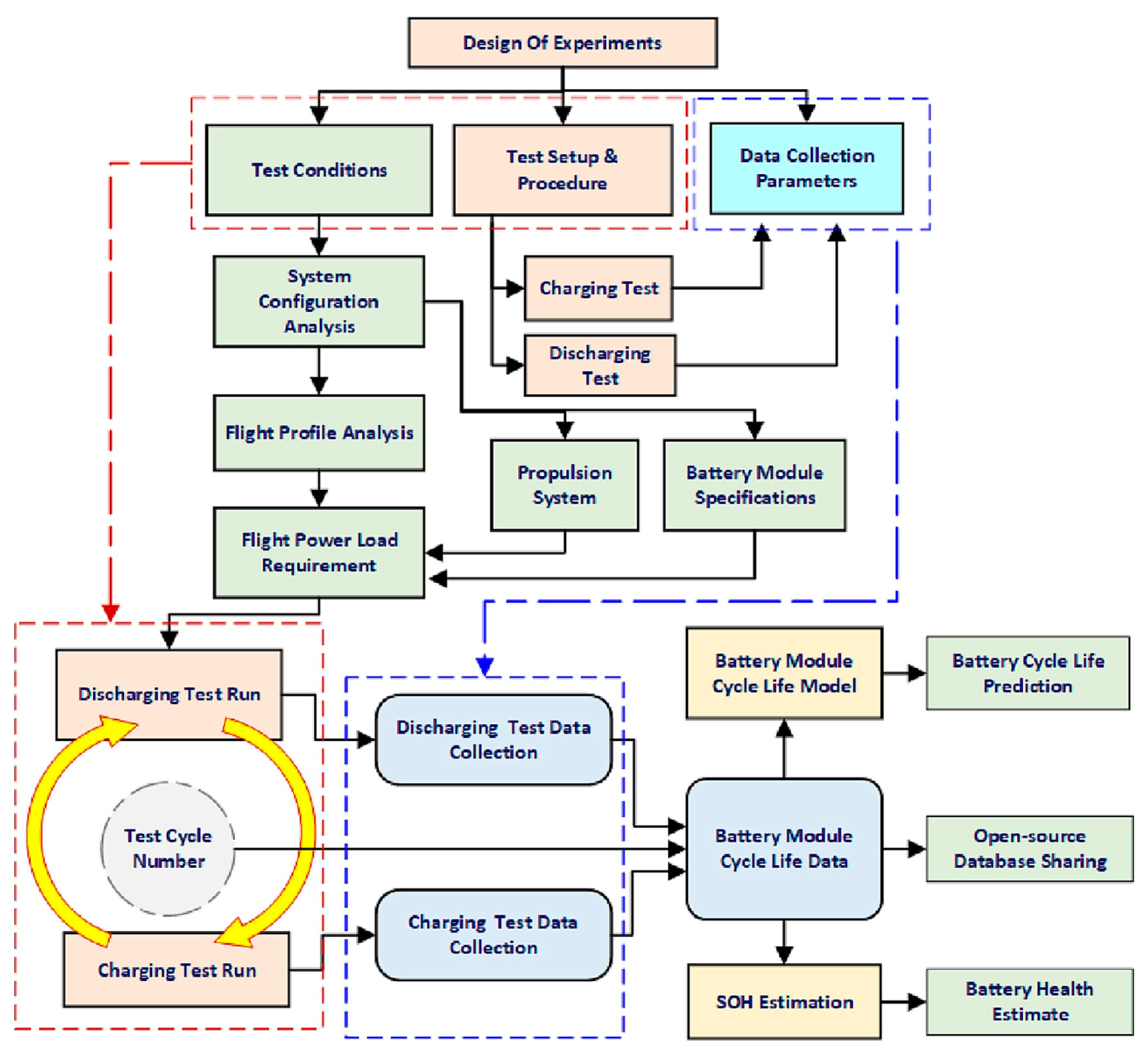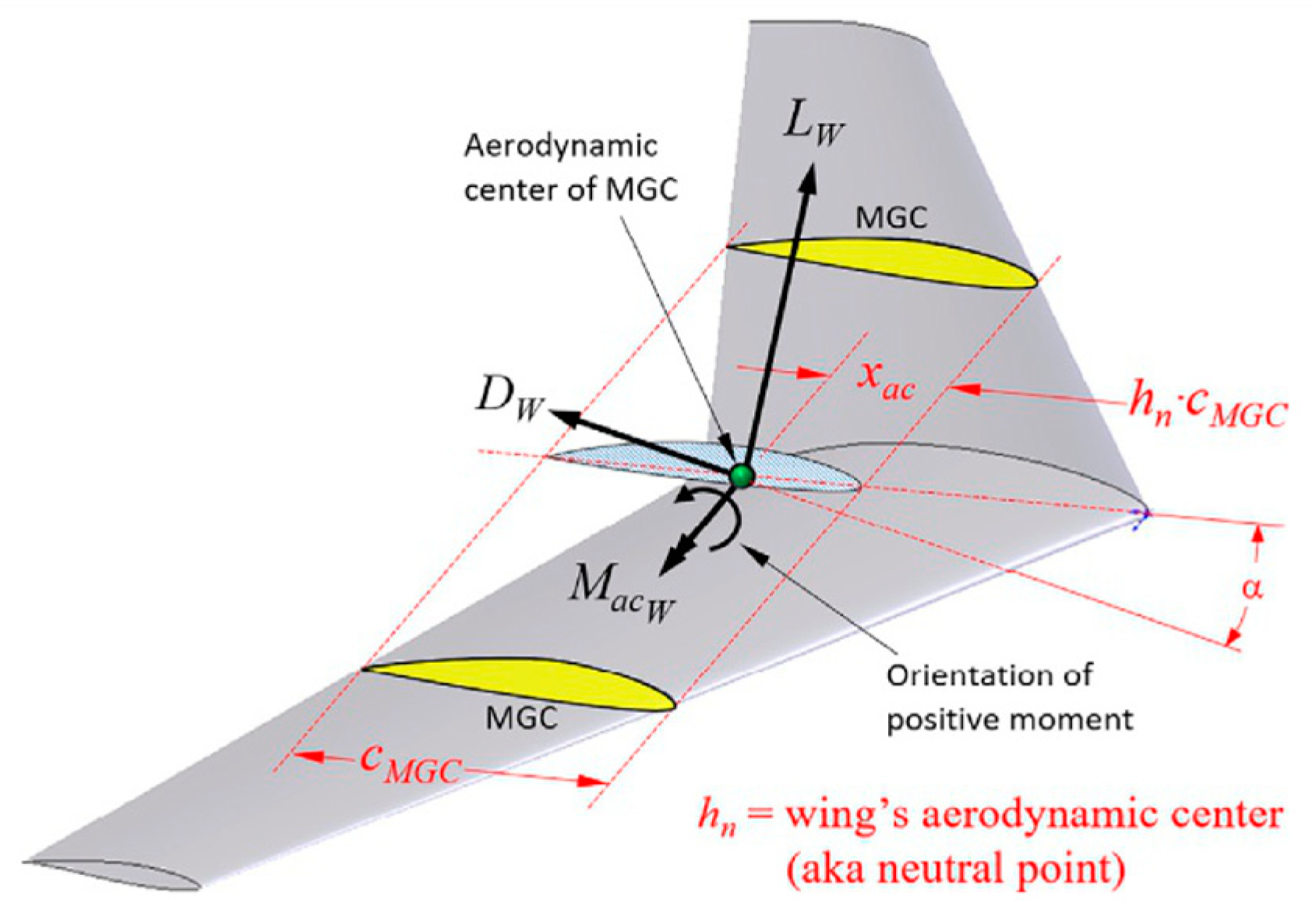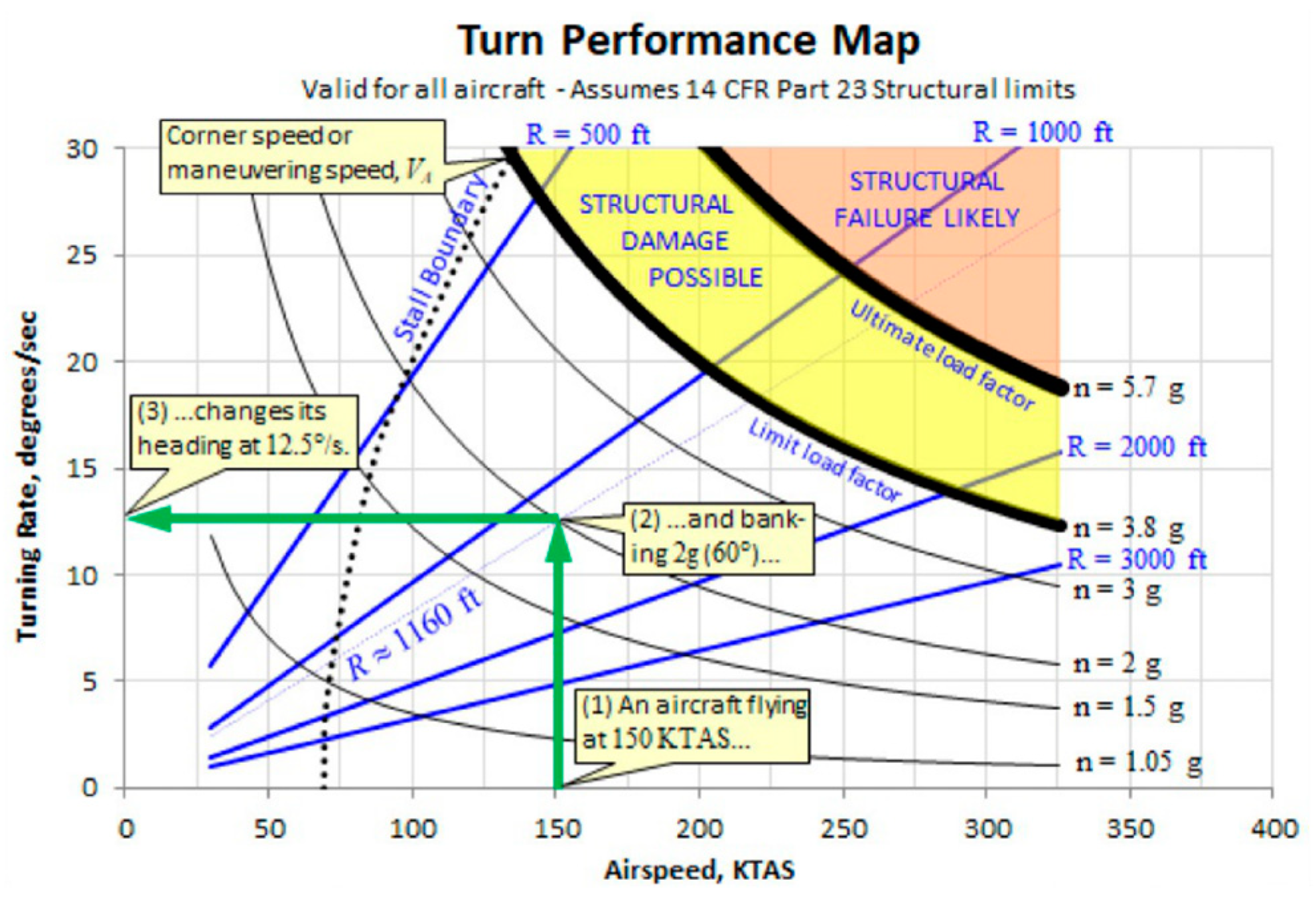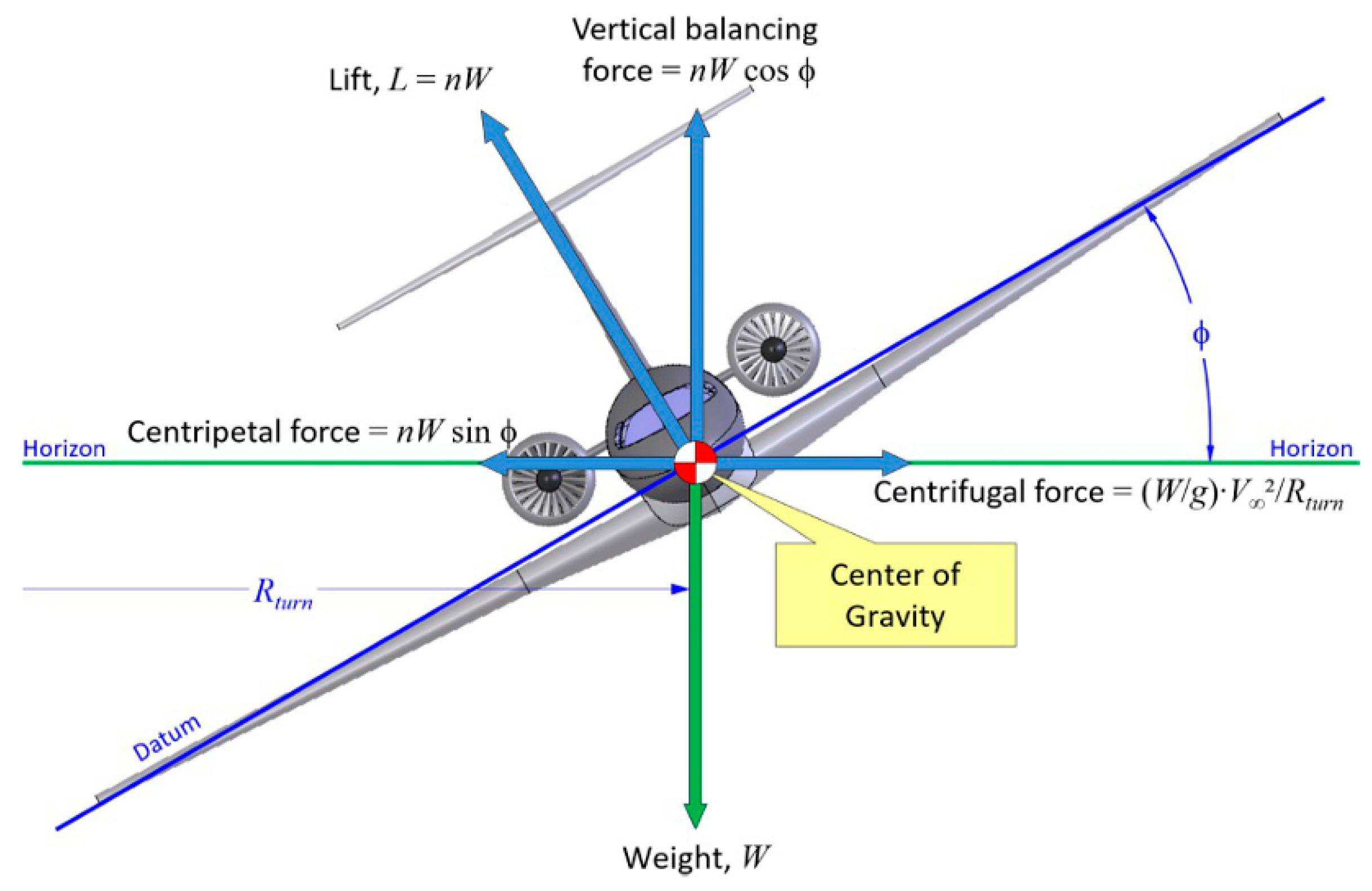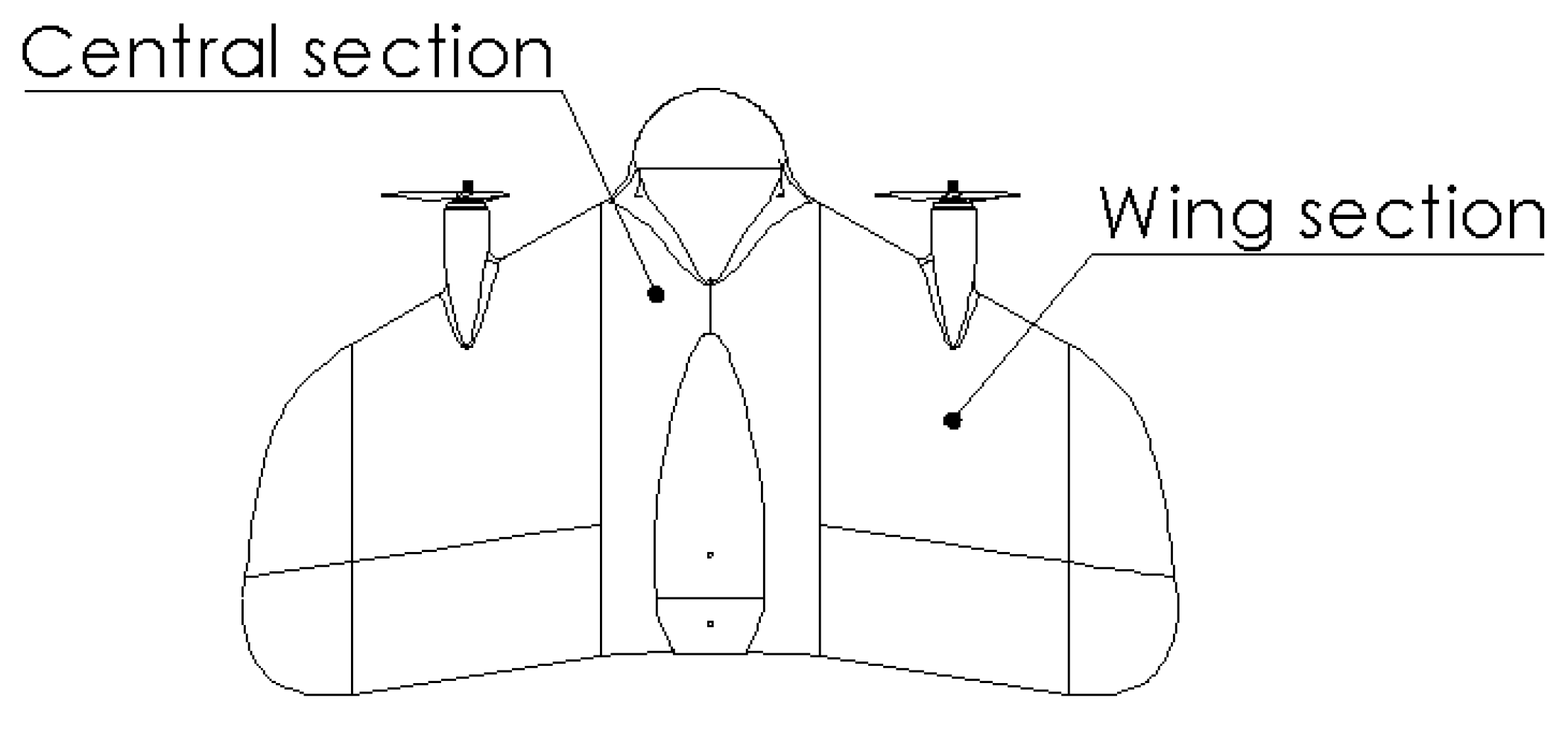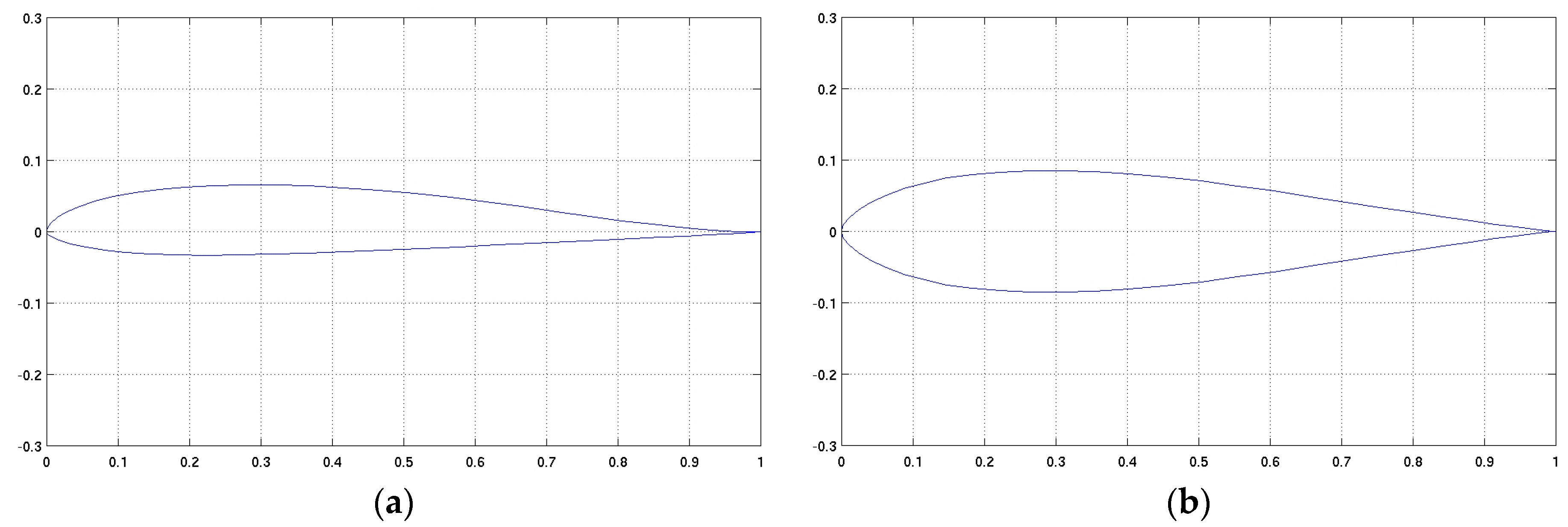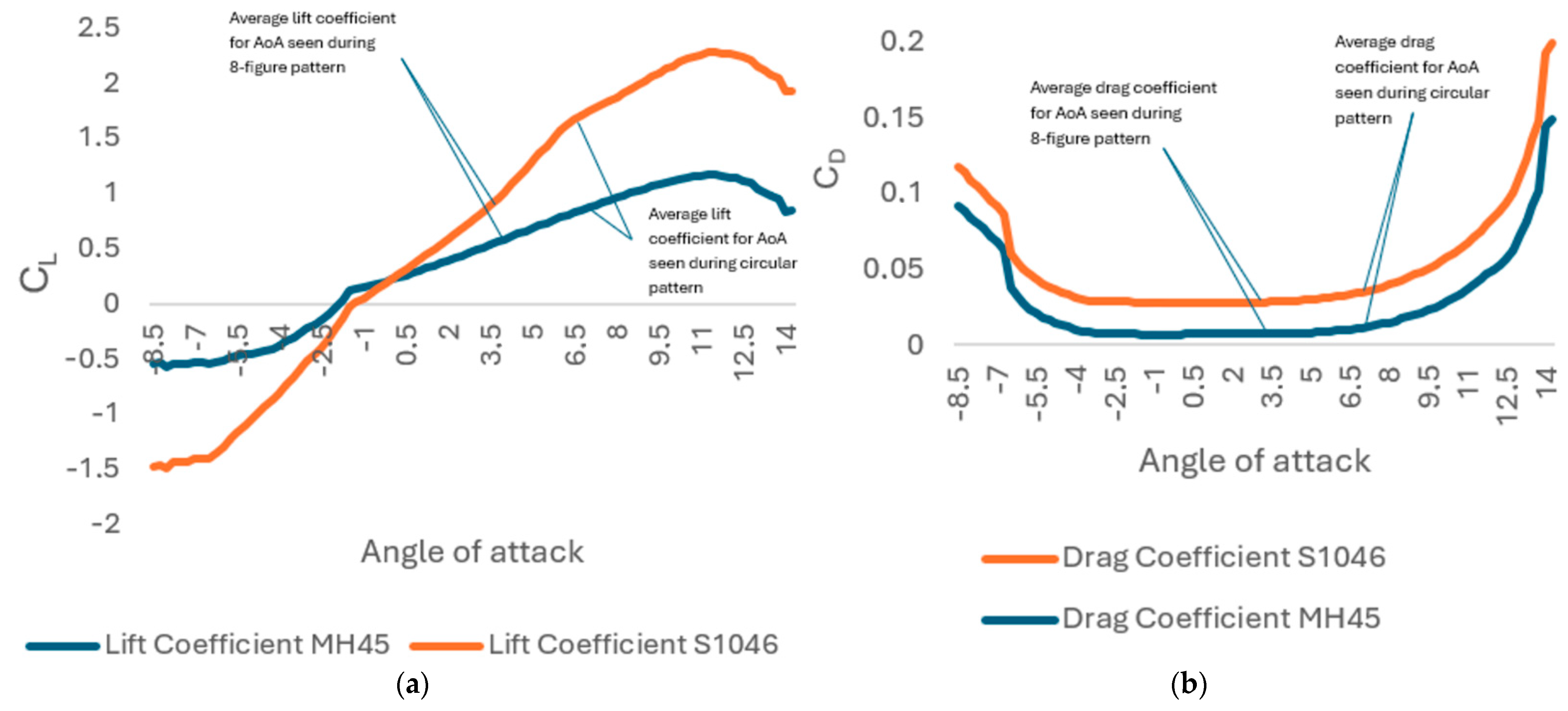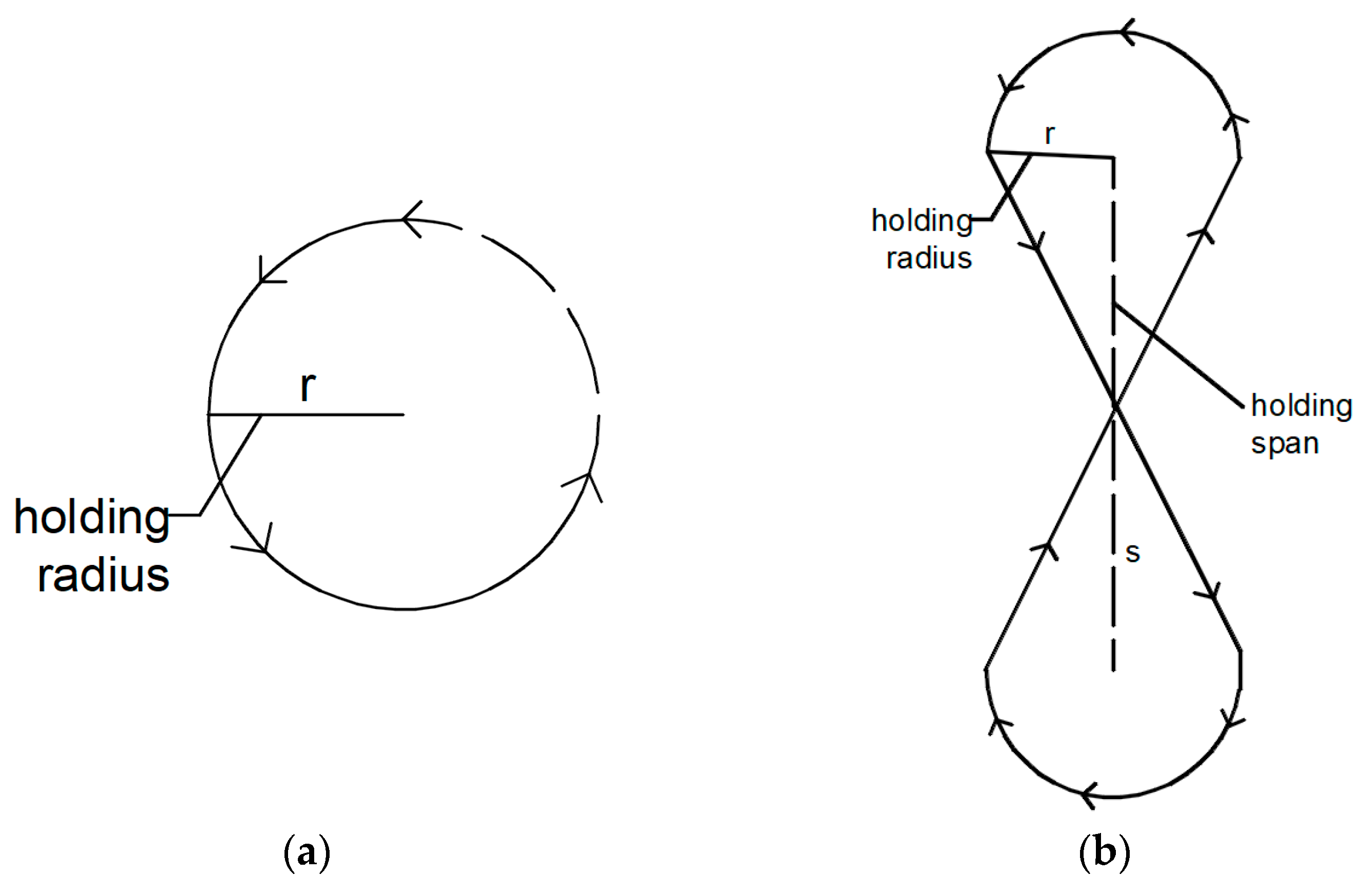1. Introduction
Unmanned aerial systems have become an integral part of modern low-altitude aerial operations [
1]. Among these, the micro-class flying-wing UAS “PADA—Powered Autonomous Delivery Aircraft” will be discussed in this article. PADA was designed and flown under SAE Aero Design 2022 and 2023 international competition rules [
2,
3], which exemplified the innovation potential in small-scale unmanned aerial systems. PADA was engineered for missions requiring precise payload delivery and autonomous operations that include executing accurate landing on designated targets that will be found during aircraft holding at low attitude. Besides altitude constraints, the final descent moment for exiting holding into landing are defined as drop and no drop zones for PADA and are marked as show in
Figure 1. Green PADA acceptable release zones are understood as areas where aircraft can enter holding. Between green-colored zones are target landing locations that remain unknown until the unmanned system detects them during holding.
A critical element in achieving such an objective is entering a holding pattern over the area of interest for target position calculation [
4]. This is caused by one particular reason. The longer the time of holding is over the area of interest, the more time the aircraft has to catch contact with satellite systems, ensuring position data [
5]. More recorded positions and more connections made with different satellite systems make autopilot calculations more precise [
6].
A holding pattern is a predefined maneuver where the aircraft loiters over an area on a certain radius or follows an elliptical pattern appointed by waypoints [
7].
For unmanned systems like PADA that demand precise target identification, holding will be even more important. External conditions such as an atmospheric phenomenon, geomagnetic storms [
8], or operational factors, such as delayed ground readiness and necessity for real-time examination of recorded data, may require a whole system to stay in a holding pattern longer than preliminarily required [
9]. An increase in time spent in holding provides enough time for the onboard sensors and computing devices to process the gained data, lock on the target, or align the aircraft for further flight maneuvers, such as descent, climbing, and even further holding in changed pattern, if required.
The concept of holding is not unique only to low-altitude airspace and unmanned systems like PADA. It is one of the fundamental flight maneuvers for all kinds of unmanned aerial systems and manned aircraft, with very diverse applications for both of them. Larger unmanned systems, such as those that can be seen in military reconnaissance [
10,
11] or commercial package delivery [
12,
13], frequently implement holding patterns as soon as flight path generation has been achieved in mission planning software. A military reconnaissance UAV can be seen performing holding in
Figure 2a,b, as its real flight recorder data were shared for public use, where flight path is represented by red line in
Figure 2.
Certain UAV operations may incorporate holding patterns as part of their approach sequence, allowing the aircraft to loiter until conditions are optimal for landing or to integrate seamlessly with other airspace users [
14]. These procedures are designed to ensure that UAVs can safely and efficiently transition from mission execution to recovery, even in complex airspace environments. Such holding and loitering may also be a result of previously mentioned onboard sensor and computer calibration or still ongoing data processing. Being capable of incorporating such maneuvers into mission profiles anytime a need may arise is a feature of the high resilience that the unmanned system has. The implementation of such maneuvers, however, could not be achieved without proper energy management during holding itself and previous stages of the mission. Without energy left in the batteries or fuel in the tanks, performing holding is not possible and would pose a danger to the system or the aircraft itself [
15].
Holding and initial approach patterns in manned aviation represent significantly more standardized procedures [
16]. Those patterns evolved during many years of flying during various types of air traffic, ground service level of training, or atmospheric conditions, especially in instrument flight rules (IFR). A standard holding pattern consists of right-hand turns with very specific entry flight parameters, such as holding speed, altitude, and characteristic geographical locations or buildings as holding turn indicators. Holding patterns are key to efficient air traffic management by allowing aircraft to maintain a safe distance from others while awaiting clearance for landing or further routing. Entry into these patterns is carefully managed based on the aircraft’s approach angle. Direct, parallel, and teardrop entry techniques are used to start the holding procedure [
7], and this aspect will be the same for unmanned aerial systems. These objectives secure smooth integration into the pattern while maintaining separation from other aircraft.
Holding is carried out so that UASs will be adapted to the mission profile of a particular drone and mission-specific goals of flight. The characteristics of a wide range of different fixed-wing, flying-wing, and rotorcraft UASs are dependent on how particular unmanned aircraft may enter or endure in low-altitude holding. In the context of unmanned systems, loitering and holding will refer more to a prolonged phase of flight in which the system will gather additional data, as mentioned in the introduction, await further instructions, perform payload operations, or wait for navigational and computing components to respond and synchronize the data with the flight plan and ground control station. The specific flow of the research is shown in
Figure 3. It starts with the selection of the unmanned aerial vehicle and defining the research constraints, including the choice of holding patterns.
Patterns will be dictated by the mission and may be circular or figure-eight. For instance, UASs may loiter in a tight circular or figure-eight pattern like PADA while gathering specific data about the landing target as a point of interest and connecting with more satellites each minute of flight to introduce better satellite positioning corrections. The same holding pattern can be used by UASs that gather surveillance information or work on high ceilings to operate as an additional communication device. On the other hand, delivery drones will adapt their holding patterns with right-hand turns and prolonged straight cruise phases to await clearance for package drop-off. Additionally, these patterns can be deployed as preprogrammed trajectories or real-time adaptive adjustment-based controls that are suited for the performance category of an aircraft.
The guidelines for energy-efficient loitering and holding patterns for unmanned aerial systems, especially those that are considered light class in terms of EASA regulations [
17], are highly anticipated. This is especially true for aircraft that stay in the open category flying rules while not exceeding 25 kg in maximum take-off weight or 3 m in any geometrical dimension. The aim of this work is to present estimates of the differences between theoretical and experimental energy consumption values. A model of such energy consumption dedicated to this class of light unmanned aerial vehicles has been found to be nonexistent during the literature review.
2. The State of the Art
The growing interest in implementing unmanned aerial systems into branches such as environmental monitoring, agriculture, deliveries, or search and rescue missions generate questions about the profitability of such solutions. That profitability is strictly connected to the endurance of such systems and their energetic efficiency. The energy management of unmanned systems is a key factor in operational cost estimation and operational safety analysis. Understanding the factors influencing the specific energy consumption, such as that of the aerodynamic drag of an airframe or propulsion system characteristics, is essential.
Unmanned aircraft energy consumption models exist widely in the literature, but they vary in terms of model scope, which is not always suited for the purpose of light unmanned systems. The aim of this literature review is to present methods for evaluating the energy consumption of light unmanned systems and electric power systems of adequate sizes.
Traditional empirical models and modern energy consumption methods more often use the performance of the battery as the crucial parameter for assessing drone performance. In a study from 2023 [
18], the life cycle of a battery during lift and the cruise phase of VTOL aircraft has been investigated. The research focused on the power consumption from lithium-polymer batteries during the vertical flight stage. In that study, a regression model for predicting the health of the battery has been developed, and the remaining useful life of the batteries has been calculated. In this model, supportive maintenance strategies to sustain airworthiness under high discharge rates typical for UAV operations, especially vertical take-off, have been outlined. A design of an experiment for such research can be seen in
Figure 4.
Another battery-dependent energy conservation method was presented as fuel cell application in unmanned systems [
19]. In this solution, hardware such as batteries and fuel cells were mitigated to perform in ranges of the highest efficiency. It states that, because power can be distributed between both energy sources systems, economy can be achieved, as well as fuel cell degradation reduction.
An approach more focused on the amount of payload taken has been presented by Mauro Gatti et al. [
20], where a prediction model for hovering UAVs was developed. The model predicts the endurance of battery-powered rotary-wing aircraft. Their model takes into account battery capacity and rotor characteristics, but the most important part of the model is the ability to relate the total weight of an aircraft to the amount of cargo taken with the energy consumption of the electric propulsion of that UAV. The theoretical flight endurance to battery capacity ratio is shown in
Figure 5. The results are valid for the same configuration, where the only variable is battery capacity.
While in some papers researchers focus on the parameters of the battery or weight of an airframe itself, there has been a study [
21] that directed the scope of the evaluation on the speed of the drones. An energy minimization and range-constrained delivery drone problem has been introduced. In that study, the speed and possible launch area of an unmanned aircraft were selected according to formula that allowed the reduction of energy consumption. Such a model explicitly calculates energy use based on the speed of an aircraft. It needs to be pointed out that, however good the estimates of this model are, it was designed for a large swarm of unmanned systems and must consider multiple location-dependent flight paths in order for the system to work.
Another paper that focuses not specifically on battery or UAV parameters is presented by Yafei Li [
22], where the researchers show that path planning can be crucial for energy consumption estimates. The path planning method for VTOL UAVs operating in urban areas was introduced. In their model, by using Voronoi diagrams, Dubin paths, and the Floyd algorithm, a UAV can follow an obstacle-free energy-efficient flight path. This study reveals that choosing an obstacle-free path can minimize energy consumption and extend flight range. The second work considering path planning using IoT Networks was presented in [
23]. A model of nonlinear energy consumption for UAVs was presented. Using IoT devices, the UAV flight path can be calculated in this model using Dubin curves. Such implementation reduces the time of a flight and, therefore, conserves UAV battery.
Liu Hao presents cooperative arrival time and energy consumption optimization in UAV flights utilizing formations [
24]. This study constructs a theoretical model showing that all aircraft need to reach designated task points while maintaining minimal energy consumption. This model utilizes the rotorcraft design of UAVs and considers acceleration, cruise speed, and hover energy consumption of a single rotorcraft in formation. Later, the algorithms for formation path planning using two optimization techniques were designed.
Cabuk et al. [
25] investigated the energy consumption of drones with a maximum take-off weight of less than 2 kg. In this paper, the aim is to develop an estimation for energy consumption in drones used for imaging, delivery, and surveillance. The model utilizes various factors, from the weight of a UAV to its aerodynamic and propulsion characteristics, and in addition introduces formation swarm path planning strategies. With key findings such as stating that the hover maneuver consumes the most energy, this study once again is narrowed to rotorcraft drones not fixed-wing platforms.
Despite the growing society of researchers working on energy consumption models for unmanned systems, there is still a lack of a tailored approach that could combine dynamic power management with path planning capabilities. The literature review serves as a foundation for developing a theoretical energy consumption model for the “PADA”, however, there has not been enough research carried out for light unmanned aerial aircraft such as the one studied in this paper. The research result will allow for a comparison of the developed model with existing approaches. The crucial factor taken into account in the presented model can be seen in
Table 1.
3. Analytical Drag-Based Model of Energy Consumption
To evaluate the impact of aerodynamic drag on the flight efficiency and energy consumption of the electric propulsion system during maneuvers, two flight patterns are analyzed. The PADA unmanned aircraft performs two types of holding paths, encountering different aerodynamic force distributions from a flight mechanics perspective. The analyzed maneuvers are stabilized level flight and steady-speed coordinated turns. For each maneuver, the required thrust generated by the propulsion system varies, directly affecting energy consumption. The equations of motion and drag prediction are derived from the methodology presented by Snorri Gudmundsson [
26,
27,
28].
In stabilized level flight, the aircraft follows a straight path at a constant velocity, balancing lift and thrust with drag. In steady-speed coordinated turns, additional thrust is required to counter the increased lift demand due to the bank angle. Thrust and drag calculations use Snorri Gudmundsson’s flight mechanics methodology, with thrust equations defined by the drag force, lift coefficient, and airspeed. The aerodynamic characteristics of the PADA airframe are modeled using the MH45 airfoil for the wing and the S1045 airfoil for the central section. A quadratic drag model, incorporating lift-induced drag and Oswald efficiency factors, is applied. The drag characteristics are computed for various angles of attack using lift and drag coefficients specific to each airfoil section. This analysis clarifies the airframe’s aerodynamic behavior across different flight regimes.
The theoretical flight parameters are defined based on competition rules and flight mechanics models. The UAS has a mass of 0.454 kg and a wing area of 0.079 m2. During holding maneuvers, PADA flies at 13 m/s for turns and 16 m/s for straight segments, aligning with the competition requirements. The theoretical energy consumption is estimated for two holding patterns: a circular pattern and a figure-eight pattern
3.1. A Stabilized Cruise
A stabilized leveled flight is a flight along a straight path, with a vector in which the velocity of an aircraft remains the same. In such a flight regime, the forces acting on an aircraft are lifting force pointed perpendicularly to a movement vector and a vertical component of thrust if an aircraft has an engine tilt angle that is equalized by the weight of the aircraft pointed vertically down. The draft force is directed oppositely to a movement velocity vector that is equalized by the thrust of a propulsion system [
26]. Both cases can be seen in
Figure 6.
Therefore, forces acting on an aircraft in stabilized leveled flight will take the following form:
where
T—thrust,
m—mass of an aircraft,
—airspeed,
D—drag force,
L—lift force,
—angle of attack, and
—engine inclination angle.
The point of the interest in thrust will be determined as necessary thrust
in order to obtain and maintain the stable velocity of an aircraft during leveled flight. Such equations can be obtained from a drag force and coefficient of an aircraft and will take the following form:
where
TN Horizontal—necessary horizontal component of thrust needed to sustain flight,
TN Vertical—necessary vertical component of thrust needed to sustain flight,
CL—lift coefficient,
CD—drag coefficient,
S—characteristic area of the evaluated object,
b—span of a wing, and
—density of air.
The forces working on the aircraft can be also illustrated as shown in
Figure 7. As the evaluated aircraft will be PADA, which is a flying-wing design, the values marked as the lift force of wing
and the drag force of wing
are equal to lift force L and drag force D of a whole airframe.
3.2. A Level Constant Velocity Turn
A turn, as an aeronautical maneuver, can be called a steady or level constant velocity turn. Such nomenclature can be used only if the turn had been performed with the constat velocity at a constant height and no sideslip or skid occurred during the turn. The boundaries of the steady turns are determined by the range of speeds and loads at which the maneuver can be performed. The radius of the turn will depend on three main factors, including the safe lift coefficient
, which will be the lift necessary for maintaining the altitude; the amount of thrust that is available from the propulsion system; and the maximum acceptable load that an airframe is designed to withstand. A turn performance map can be seen in
Figure 8.
During the steady turn performance, the lift of an aircraft will work on equaling the airframe weight, but the horizontal component will also generate centripetal force to balance the centrifugal force. Such force balance allows an aircraft to maintain a steady heading change. Because of the banking angle, and the fact that part of the lift is not available to equal the weight of an aircraft, an enormously important part of maintaining weight–lift balance will be thrust. The vertical component of thrust will be used to eliminate the gap that occurs because of the aircraft’s bank angle. Therefore, the force equations applicable during a steady turn will be as follows:
where
TN—necessary thrust,
D—drag force,
L—lift force,
—airspeed,
—bank angle,
—radius of a turn, and
W—weight of an aircraft.
The forces is illustrated in the aircraft image shown in
Figure 9.
It is clearly shown that, once the bank angle increases, the amount of necessary lift and thrust required to maintain steady parameters of flight also increases. Such a turn can be also evaluated using several equations for bank angle value, load factor, turn radius, or time to turn
degrees.
As PADA purpose according to SAE Aero Design rules [
2,
3] requires it to be extremally maneuverable, the maximum turn rate parameter needs to be mentioned. The maximum turn rate is a parameter of an aircraft that defines its ability to perform maneuvers. This is the fastest heading change rate that the airframe can withstand and presents as follows:
where
n—g load,
Tmax—maximum thrust, and
—heading change rate.
3.3. PADA Aproximate Drag Characteristics
To estimate the thrust needed to perform any of two types of flight presented in the discussed energy consumption evaluation approach, the drag characteristics will be needed. A drag force estimation will be introduced as a mathematical expression of the drag coefficient for an airframe. The airframe of the PADA consist of two main sections and can be evaluated as a blended body design with a central section and a wing section. A drawing of a PADA aircraft can be seen in
Figure 10. The airfoil used both in the central section and the wing section can be seen in
Figure 11.
Knowing the exact airfoils used in the sections of the airframe, the aerodynamic polars can be obtained for both of them. Knowing the drag and lift coefficient characteristics for various angles of attack (shown in
Figure 12), the model of drag can be introduced. The quadratic drag model will assume that the drag of a wing will increase as the squared lift coefficient increases [
28].
The simplified form of the quadratic drag model and its adjusted form, as the more accurate one, can be seen with the following equations:
To begin with drag calculations, another constat k needs to be introduced. Constant
k adds to the drag estimations and the lift-induced drag part when the lift coefficient is squared. The lift-induced drag constant, k, can be described with the following equation:
Therefore, knowing the equations for both quadratic drag estimations and the corrections that need to be applied because of lift-induced drag and the Oswald aspect ratio, the summary equation for the drag of the PADA can present as follows:
where
CL—lift coefficient,
CD—drag coefficient,
AR—aspect ratio,
ARe—aspect ratio with Oswald correction,
k—lift-induced drag constant load,
—change in aerodynamic coefficients in a function of wing span b, and
e—Oswald efficiency number.
As the drag and lift coefficients will change spanwise, it is important to know the exact geometrical properties of the wing, such as the mean geometrical chord, aspect ratio, and location of the mean geometrical chord, all of which have been calculated for the purposes of airframe drag and lift force evaluation. In the following chapter, the equation and characteristics of the lift and drag coefficients of the PADA airframe have been calculated. The results can be seen in
Figure 13.
Knowing the aerodynamic characteristics of the PADA further required thrust calculations to be made. Following SAE Aero Design rules, the mass of the PADA is required to be 454 g. The radius of the holding, as well as the span of holding in terms of the figure-eight holding pattern, are also defined by competition regulation and fly zone dimensions. The angle of attack required to maintain the two presented flight regimes has been calculated. The parameters of the PADA and the calculated theoretical angle of attack and bank angle are presented in
Table 2. When we have the lift required to maintain a certain holding pattern, the calculated drag coefficient of an aircraft for that particular angle of attack can be read too.
Calculations have been made assuming that the constant velocity of 13 m per second during both turns and the circular pattern needs to be maintained for the purpose of accurate data gathering, and an increased speed of 16 m per second can be applied at the straight parts of the figure-eight path without distortion to avionics. As the airframe was referred to as a flying wing, an estimation of the engine pod drag was added to the overall drag. The maximum load that an airframe can handle was set as n = 1.5 for avionics on board to deliver precise measurements. The aircraft itself was designed to withstand much bigger loads of at least n = 6. An analytical drug estimation revealed that, theoretically, the PADA will generate the drag forces shown in
Table 3.
Once the amount of thrust needed to maintain the considered flight regime is known, the time of a single holding loop for both patterns (as shown in
Figure 14) must be calculated. Following the SAE regulations, both the radius and span of the evaluated holding pattern are set. The radius of holding is 30 m, while the span of holding is 250 m. Using mathematical equations for the circle perimeter, the length of the holding path can be calculated. Assuming that the speed of an aircraft during holding is said to be constant and equals 13 m per second, the time spent in holding can also be obtained from the uniform motion formula. The time spent in holding is the second most important thing to consider next to the thrust required by the propulsion system in the presented theoretical model. Given the entry data, the formulas and times of holding present in following equations:
As can be calculated from Equations (22)–(25), the times of holding for the circular holding pattern and the figure-eight pattern are shown in
Table 4. The time of holding needed to complete the mission and the PADA to gather enough data has been established as 300 s based on the PADA performance during the competition. Using the formula for energy used, the theoretical amount needed to complete both patterns a single time, as well for the whole holding time, is also presented in
Table 4.
4. Case Study
Real-world tests were performed on the PADA flying platform. This is an aircraft that allows vertical take-off and landing, but this is not considered in this study. The test flights were carried out to reflect, as closely as possible, the model subjected to analytical calculations. The configuration shown below was adopted for the model.
4.1. UAS Configuration
The aircraft configuration is suitable for horizontal flight, as well as vertical hovering. The model is equipped with two electric motors (model T-Motor F2203.5 3550 kV, manufacturer T-Motor, Nanchang, China) fitted with 5 × 3.5′ three-blade propellers, thereby giving a maximum thrust for the entire propulsion system of 1404 g, making vertical flight possible. During the horizontal flight trials, the system demonstrated high propulsion efficiency, with a specific thrust that exceeded 6 g/W over a range up to 40 W of power what is shown in
Figure 15.
The PADA aircraft depicted in
Figure 16 was utilized to conduct the measurements. The measurement configuration seen in
Figure 17 incorporates a 3S LiPo battery (see
Figure 18b) with a maximum current rating of 25 A (Imax = Capacity [Ah] × C = 1 × 25 = 25 A).
The procedure for measuring energy consumption is outlined below, as follows:
The utilization of a battery with a known starting voltage for the powering of the PADA.
The system is then configured to record the initial voltage and capacity utilized prior to the start of the flight.
The measuring unit employed in this procedure, illustrated in
Figure 18a, is equipped with the INA139 variable gain current sense amplifier, which is calibrated with a zero-current condition before flight.
The system then confirms receiving of an analogue signal on the analogue-to-digital converter (ADC) of the STM32 microcontroller.
The data are then sampled at regular intervals throughout the flight, with the frequency specified in
Table 5.
For analysis, all signals are interpolated with sampling of 100 Hz, which was carried out using MATLAB R2024b flight analyzer software.
The state of charge (SoC) is estimated using real-time voltages and current measurements, which continuously track the battery discharge level. Using fixed limits set by the battery manufacturer, i.e., 4.2 V as maximum and 3.4 V as minimum, and with information about battery cycles, the flight controller has access to the remaining battery capacity and can predict the available flight endurance
4.2. Flight Trajectories
The investigation focused on two distinct patterns: circling at a designated altitude and flying in the eight trajectory.
The test flights were conducted in a range of meteorological and wind conditions, and the relevant data were obtained. In the case of shape eight, the flight was conducted with wind along and across the aircraft’s trajectory. In addition to the current and battery voltage measurements, a series of parameters were examined, including the pitch, yaw, deviation from heading, flight altitude, ground speed, and airspeed.
This methodological approach facilitates the determination of power consumption during the execution of one of the holding patterns.
4.3. Circular Holding Pattern
This study compares data collected for circular trajectories at a fixed radius of 30 m and a height AGL of 13 m. Metrics, including the mean pitch, mean roll, mean power consumption, mean airspeed, mean ground speed, and mean barometric altitude, were assessed for multiple flight iterations gathered in three sets. Within set one, the airspeed was lower, while set two and three were differentiated by the weather conditions, i.e., wind direction and gusts.
Table 6 provides a synopsis of the data.
The test results, illustrated in
Figure 19, demonstrate the flight trajectories achieved during the experimental flights, with each set comprising multiple flights, achieving an average of four laps per flight.
As is evident, the flights were conducted in stable conditions, and the flight parameters are repetitive among the flights. The aircraft’s circling was indicated by stable flight dynamics, characterized by a mean pitch angle of 7.02° and a mean roll angle of 23.11° for all sets. A discrepancy in power usage was observed between the initial data records and subsequent records. On average, the power consumption was 10 W in the same circulation conditions. This discrepancy is attributable to the variation in the airspeed settings for this particular flight, wherein the airspeed was reduced to 11 m/s, as opposed to the original setting of 13 m/s. This results in a similar ground speed, but the power consumption is reduced by 25%.
The conversion of average power consumption to mean thrust generated during the flight was conducted on the basis of prepared sets. The data presented in
Table 7 illustrate the total thrust, which is the sum of the thrust from both motors.
4.4. Energy Consumed
The energy consumption for both the circular and figure-eight holding patterns was determined based on the measured power values and a standardized flight duration of 300 s. The total energy used by the propulsion system was calculated using the following relation [
31]:
where
E represents energy in Watt-hours (Ws), P is the average power consumption in Watts (W), and t is the flight duration in seconds.
For the circular holding pattern, the mean power consumption across all test sets was 37.35 W, leading to an estimated energy consumption of the following:
For the figure-eight holding pattern, the power consumption varied across flight iterations due to the combination of curved- and straight-line segments. The average power consumption was 21.13 W, resulting in an energy consumption of the following:
4.5. Flight Test Energy Consumption Measured Against Theoretical Model
The results indicate that the figure-eight trajectory consumed approximately 24% less energy compared to the circular holding pattern (
Table 10). This suggests that the inclusion of straight segments, where the aircraft experiences reduced aerodynamic drag and requires lower thrust, contributes significantly to energy efficiency. The continuous turning in the circular pattern leads to higher power demands due to sustained control surface deflections and aerodynamic resistance. These findings highlight the potential for optimizing holding strategies to improve UAS endurance and operational efficiency.
Consequently, it is possible to compare the efficiency of such a flight for a light UAS and optimize the given conditions to increase the flight capability and reduce the energy consumption of the drone. The theoretical model used to estimate energy consumption implemented several key factors, as presented in
Table 11, that should be considered based on the literature review. Despite this fact, the discrepancy between the theoretical data is significant.
Having calculated the amount of energy needed to perform holding according to two different patterns, it is clear that at least 30% excess capacity is needed to perform the mission safely. The energy capacity needed to perform both circular and figure-eight patterns has been estimated theoretically. The empirically measured capacity needed is on average 30% more than that of the theoretical data. Therefore, the amount of energy needed to at least perform a single mission is 30% higher than the theoretically assumed value for a particular light fixed-wing unmanned aerial system. The amount of energy used can be strictly connected to propulsion characteristics, aerodynamic characteristics, total take-off weight of an aircraft, and the speed of holding, as well as the path itself. The equation for estimated necessary battery capacity for light unmanned aerial vehicles developed according to the presented model is as follows:
where
ENecessary—battery capacity to perform flight,
FD—flight distance,
PN—power consumption necessary to perform flight,
PD—theoretical drag force working on an airframe,
VH—holding velocity, and
ST—specific thrust.
Knowing the equation, the estimation can be made, and, for the PADA UAV, the necessary battery capacity was calculated as 11,205 Ws for the circular holding path and 6339 Ws for the figure-eight path. The aircraft is equipped with a 1000 mAh lithium-polymer battery, which has an energy capacity of 11.1 Wh or 39,960 Ws, while delivering 11.1 volts. The battery weight is 70 g. The excess capacity for the circling holding pattern for the PADA aircraft is 256% and 501% for holding in the figure-eight pattern, which is six times the size of a battery that is needed. Knowing that the average energy density of lithium-polymer batteries is close to 175 Wh per kilogram [
32], the mass of a battery that could power the PADA for a whole holding pattern could be 11.79 g for the figure-eight pattern and 10.06 g for the circular pattern. This is, consequently, 16.84% and 14.37% of the originally installed battery mass. The reduction in the mass of the battery could significantly extend the range of an aircraft or decrease the energy consumption by reducing the amount of speed and, therefore, thrust required to keep an airframe airborne and able to maintain a certain flight regime.
5. Conclusions
Two holding patterns were evaluated using the Powered Autonomous Delivery Aircraft, PADA. Some of the flight pattern restraints and PADA parameters have been taken as constant due to SAE Aero Design competition rules. For both holding patterns, flights have been executed at an altitude of between 13 and 15 m AGL. The aircraft was equipped with two T-Motor electric motors with three-blade propellers. Data from avionics were collected, allowing us to assess the energy consumption based on the current measurements and battery voltage. The current and voltage samples were collected simultaneously with airspeed, pitch, roll, ground speed, and altitude parameters. For the circular pattern on the 30 m circling radius, the average energy consumption across all sets of data was 37.35 Watts per second and was 31.24% higher than that observed in the theoretical model. For the figure-eight pattern, the average energy consumption across all sets of data was 21.13 Watts per second and 29.63% higher than that observed in the theoretical model. Variability in wind conditions and minor deviations in airspeed contributed to the discrepancies. While both holding patterns experimentally deviate from the theoretical model significantly, they both are different from the theory by similar values; therefore, the same thing should influence the practical data gathered during flight. It is probable that the factor that influenced the PADA and caused the discrepancies was the computational speed of the onboard computer and its ability to process data from the inertial measurement unit and GPS readings. Because of that, some of the turn indication moments have been delayed, causing the whole pattern to drift with a certain translation. That pattern shape is slightly different from the ideal theoretical holding pattern shown in the theoretical model. Despite the discrepancies between the theoretical and empirical models, the figure-eight holding pattern consumed less energy than the circular pattern, and this study emphasizes the importance of flight path selection for optimizing energy consumption in light UAS operations.


